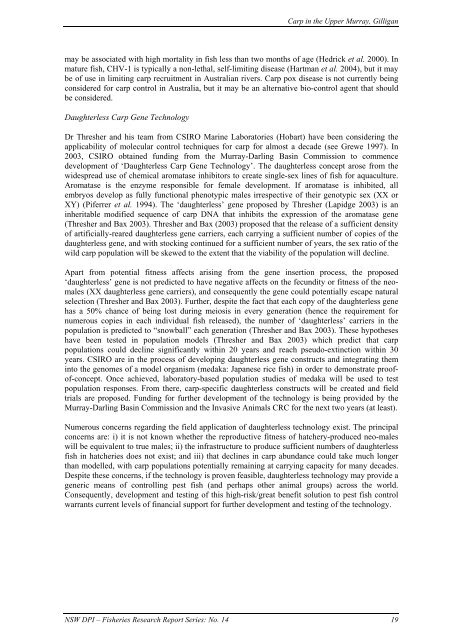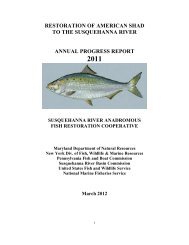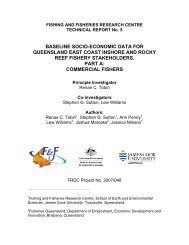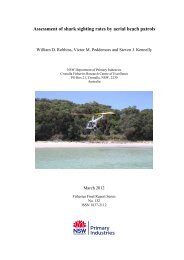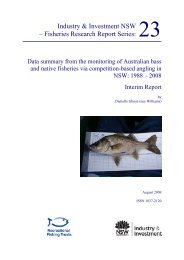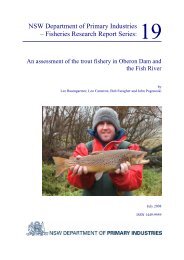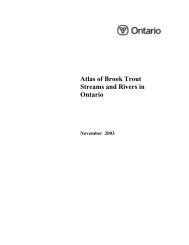NSW Research Report Series No 14 - Fisheries Reports
NSW Research Report Series No 14 - Fisheries Reports
NSW Research Report Series No 14 - Fisheries Reports
You also want an ePaper? Increase the reach of your titles
YUMPU automatically turns print PDFs into web optimized ePapers that Google loves.
Carp in the Upper Murray, Gilligan<br />
may be associated with high mortality in fish less than two months of age (Hedrick et al. 2000). In<br />
mature fish, CHV-1 is typically a non-lethal, self-limiting disease (Hartman et al. 2004), but it may<br />
be of use in limiting carp recruitment in Australian rivers. Carp pox disease is not currently being<br />
considered for carp control in Australia, but it may be an alternative bio-control agent that should<br />
be considered.<br />
Daughterless Carp Gene Technology<br />
Dr Thresher and his team from CSIRO Marine Laboratories (Hobart) have been considering the<br />
applicability of molecular control techniques for carp for almost a decade (see Grewe 1997). In<br />
2003, CSIRO obtained funding from the Murray-Darling Basin Commission to commence<br />
development of ‘Daughterless Carp Gene Technology’. The daughterless concept arose from the<br />
widespread use of chemical aromatase inhibitors to create single-sex lines of fish for aquaculture.<br />
Aromatase is the enzyme responsible for female development. If aromatase is inhibited, all<br />
embryos develop as fully functional phenotypic males irrespective of their genotypic sex (XX or<br />
XY) (Piferrer et al. 1994). The ‘daughterless’ gene proposed by Thresher (Lapidge 2003) is an<br />
inheritable modified sequence of carp DNA that inhibits the expression of the aromatase gene<br />
(Thresher and Bax 2003). Thresher and Bax (2003) proposed that the release of a sufficient density<br />
of artificially-reared daughterless gene carriers, each carrying a sufficient number of copies of the<br />
daughterless gene, and with stocking continued for a sufficient number of years, the sex ratio of the<br />
wild carp population will be skewed to the extent that the viability of the population will decline.<br />
Apart from potential fitness affects arising from the gene insertion process, the proposed<br />
‘daughterless’ gene is not predicted to have negative affects on the fecundity or fitness of the neomales<br />
(XX daughterless gene carriers), and consequently the gene could potentially escape natural<br />
selection (Thresher and Bax 2003). Further, despite the fact that each copy of the daughterless gene<br />
has a 50% chance of being lost during meiosis in every generation (hence the requirement for<br />
numerous copies in each individual fish released), the number of ‘daughterless’ carriers in the<br />
population is predicted to “snowball” each generation (Thresher and Bax 2003). These hypotheses<br />
have been tested in population models (Thresher and Bax 2003) which predict that carp<br />
populations could decline significantly within 20 years and reach pseudo-extinction within 30<br />
years. CSIRO are in the process of developing daughterless gene constructs and integrating them<br />
into the genomes of a model organism (medaka: Japanese rice fish) in order to demonstrate proofof-concept.<br />
Once achieved, laboratory-based population studies of medaka will be used to test<br />
population responses. From there, carp-specific daughterless constructs will be created and field<br />
trials are proposed. Funding for further development of the technology is being provided by the<br />
Murray-Darling Basin Commission and the Invasive Animals CRC for the next two years (at least).<br />
Numerous concerns regarding the field application of daughterless technology exist. The principal<br />
concerns are: i) it is not known whether the reproductive fitness of hatchery-produced neo-males<br />
will be equivalent to true males; ii) the infrastructure to produce sufficient numbers of daughterless<br />
fish in hatcheries does not exist; and iii) that declines in carp abundance could take much longer<br />
than modelled, with carp populations potentially remaining at carrying capacity for many decades.<br />
Despite these concerns, if the technology is proven feasible, daughterless technology may provide a<br />
generic means of controlling pest fish (and perhaps other animal groups) across the world.<br />
Consequently, development and testing of this high-risk/great benefit solution to pest fish control<br />
warrants current levels of financial support for further development and testing of the technology.<br />
<strong>NSW</strong> DPI – <strong>Fisheries</strong> <strong>Research</strong> <strong>Report</strong> <strong>Series</strong>: <strong>No</strong>. <strong>14</strong> 19


